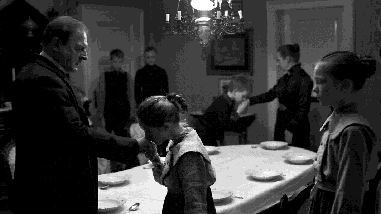The White Ribbon

The films of Austrian director Michael Haneke offer no easy answers. Haneke presents the time, place, characters and backstory before eventually revealing a problem. This might or might not become the film’s focus: other problems pop up, new characters materialize, and various possibilities present themselves. Just when you think you understand what’s going on, it slips away like an elusive fish.
Haneke’s latest, The White Ribbon, won the top prize at Cannes last year and is a strong contender for this year’s foreign-film Oscar. The story takes place in a small Protestant village in Northern Germany just before World War I. The main characters include the pastor and his large family; the widowed doctor, his children, the midwife who lives with them and her son with a mental disability; the baron, his unhappy wife, their delicate child and the child’s gentle nanny; the baron’s steward; and the tenant farmers and their families, who rely on the baron to make a meager living. A schoolteacher functions as the movie’s voiceover narrator and the town’s moral conscience.
The town needs a conscience, it turns out, because a series of bad things happens. The doctor has an accident when his horse falls over a carefully placed trip wire. The wife of a farmer falls to her death through the rotten floorboards of an old factory. A child disappears; another is almost blinded. At first, these seem like unrelated events, but as they pile up and grow more serious, the question screams out: why are these things happening, and who is behind them?
Haneke has no interest in telling us. But to help us along, he employs a favorite technique of the late Swedish director Ingmar Bergman: burrowing deeper into the social and spiritual lives of the protagonists to discover whether what is happening is a strange form of justice for their various transgressions. Once the shutters of their lives are thrown open, we are exposed to all kinds of cruelty, jealousy, intolerance, envy, perversion and hypocrisy. As we witness acts of anger and humiliation, we can’t help noticing how much of the behavior spills onto the children. If they are indeed learning from their elders, the lessons seem to be dark and evil.
By the end of the second act, the explanations for the atrocities seem boundless. Is it a case of the sins of the fathers being visited upon the sons? Is the supposedly pious town paying for a past collective sin? Or is this Haneke’s view of what Germany was like as it prepared to marshal its forces for the approaching storm?
Haneke tosses us a few tidbits to chew on. The main one is the white ribbon, which the pastor wraps around his children’s arms to remind them of the “purity” that they have within them, if only they allow it to come out. (This ceremony is preceded by a severe beating.) It is hard not to associate the white ribbon of purity with the yellow star that Jews will be forced to wear in Germany just a generation later, when these kids are grown. Are they learning the ways of evil from these random acts of violence? Or have they already started down the path to ultimate evil by trying things out on members of their own town?
Haneke isn’t saying. But as in many of his other films, if you look carefully at the final shot, which takes place in the church, you may get a sense of where he is going and what he is saying about the mystery of the town. It may not be a definitive answer, but it’s all you’re going to get from Michael Haneke, who still believes that going to the movies is a two-way street.





